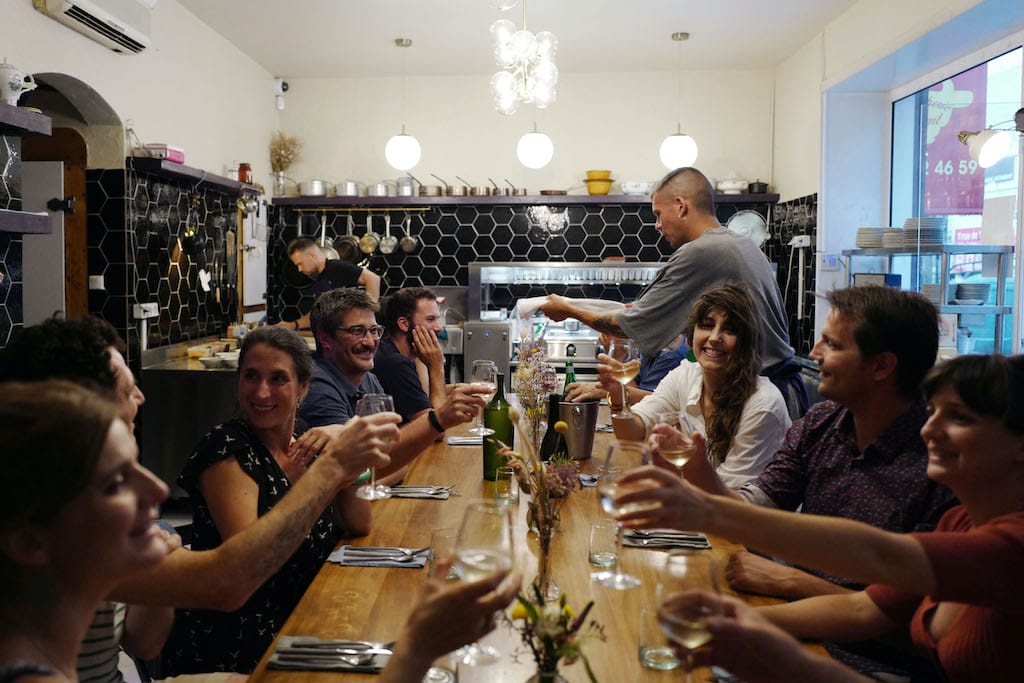Leticia Ochoa walked around Queens’ Corona Plaza, her young son in tow, chatting with each of the food cart vendors clustered around the corner of National and Roosevelt. It was a Sunday morning in February, and the sun was shining. Ochoa works as a community organizer and had helped broker an agreement between the 110 police precinct and the local vendors: If they didn’t block walkways, the police wouldn’t bother them.
As far as Ochoa could tell, the peace seemed to be holding. People flowed in and out of the plaza, stopping by the carts to buy aluminum containers laden with morcilla (blood sausage), salchipapa (salty, fatty sausages and French fries) and papa con cuero (pork skin boiled in savory broth with potatoes). No one seemed to be in a rush.
Despite the newfound amity, uncertainty lingered in the air. Ochoa knows the risks of street vending better than anyone. She grew up on Junction Boulevard, working at her mom’s street cart, where she sold Ecuadorian food. “It was crazy as a kid,” Ochoa told us, “watching all that police harassment against my mother and other vendors – the language barrier.” Ochoa, who now works as a paralegal in labor law and spends her weekends organizing for the nonprofit Street Vendor Project, had to train herself to be not only a translator for her mom, but also somewhat of a legal expert, helping to figure out the archaic rules and regulations governing vendors.
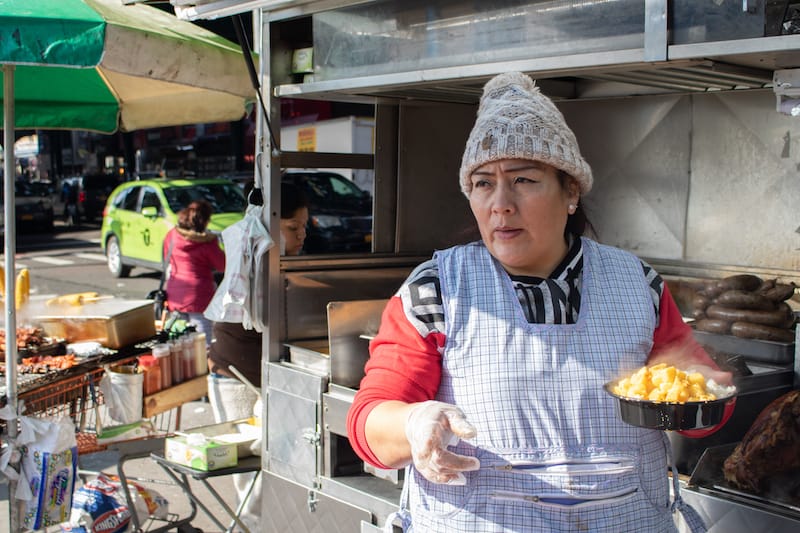
Food carts are trapped in a paradox in New York. They’re an omnipresent expression of the city’s staggeringly diverse immigrant population and serve as a powerful symbol, promoting the idea that tasty, affordable food from around the world can be found on every corner, regardless of how high property costs rise, and that running a cart can be a stepping stone to making it in America. At the same time, the people who operate food carts tend to be ignored, threatened or displaced through policing and archaic regulation – a disregard for their livelihoods that has been made plain in recent months.
The Street Vendor Project estimates that there are as many as 20,000 street vendors in New York City (this includes non-food endeavors such as street art sellers and flower carts). In 1983, the City Council put a cap on the number of vendor permits at about 5,000. Although the few lucky holders only pay $200 every couple of years to renew their permits, they rent or sell them in a secondary market akin to taxi medallions. Permits often go for between $20,000 and $25,000.
As a result, the vast majority of food vendors operate in a legal gray zone. They still receive the same health inspections as brick-and-mortar restaurants. But without an all-important permit, the vendors are subjected to tickets, seizure of property and arrests.
“The city has never considered vendors as legitimate as other types of small businesses.”
Last November, a churro cart operator named Elsa was arrested at the Broadway Junction station in Brooklyn. A pedestrian filmed as she was taken away in handcuffs, and the video went viral. To State Senator Jessica Ramos, the incident exposed the precarious nature of street vending – an issue she had built her campaign around. Just a week before Elsa’s arrest, Senator Ramos, who represents a district encompassing much of Queens, had introduced a bill that would eliminate the cap on vendor permits in New York.
Like Ochoa, Ramos grew up in Queens. She’s been living off of Roosevelt Avenue – a central corridor for food vendors – for over a decade. She said that every time she gets back from Albany, she makes a beeline for Birria-Landia, a Jackson Heights taco truck that was recently awarded two stars by the New York Times’ Pete Wells.
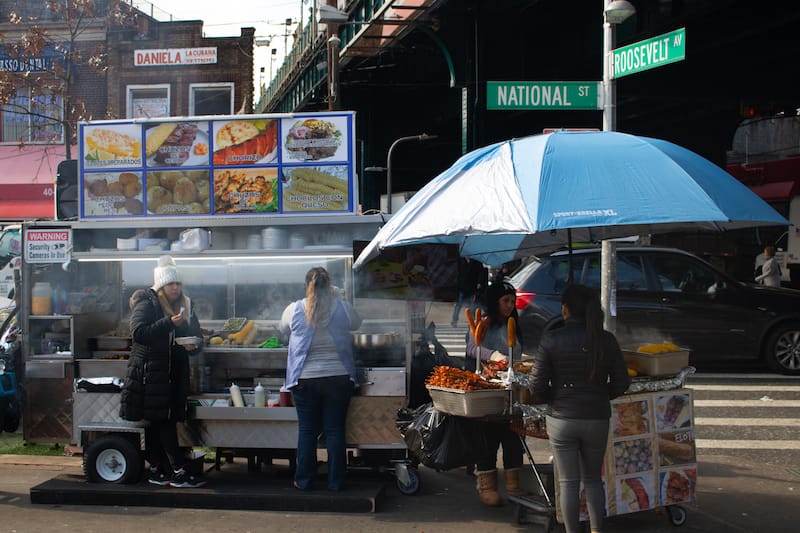
Ramos said that food carts represent the spirit of her district, which is the most diverse in the country. Many food vendors are undocumented immigrants, senior citizens, and moms who need the flexible schedule – the kind of people who often face employment discrimination. “I’ve always felt very strongly that because of our diversity, our district is who should lead on so many issues of coexistence, of human rights, of showing how it is that we support each other for the rest of the world,” Senator Ramos told us. “It’s part of our inherent cultural heritage.”
Because of the restriction on permitting, though, vendors are in constant legal peril. For Ramos, the issue isn’t only threatening her constituents, but “the entrepreneurial spirit that characterizes New York.” She estimated that lifting the cap on food permits would generate around $70 million for New York City through increased licensing and tax revenue. Senator Ramos is optimistic about the bill’s prospects: She’s partnering with Assemblyman Felix Ortiz, who represents an immigrant-rich district in Brooklyn, on the initiative and is working to find co-sponsors so that it can pass committee and become law.
Matthew Shapiro, a lawyer with the Street Vendor Project, has watched politicians try and fail to solve the permitting problem at the city level. Melissa Mark-Viverito, the speaker of the City Council from 2014 to 2017, pushed a bill that would have kept a cap in place but increased the number of permits. While Mayor Bill de Blasio initially voiced his support, he ended up changing his mind. The bill was killed before even coming to a vote. Senator Ramos is the first to bring the issue to Albany, he says, describing her as “a huge champion of street vendor rights, unlike we’ve ever had before in the state, or even the city.”
Alongside Senator Ramos’ pending legislation – which de Blasio warned would “create chaos” – the Street Vendor Project is also advocating for a new version of the city bill introduced by Mark-Viverito. Although de Blasio says he supports increasing the number of permits, Shapiro and the Street Vendor Project want to completely lift the cap on permits, whether the order comes from the city or the state.
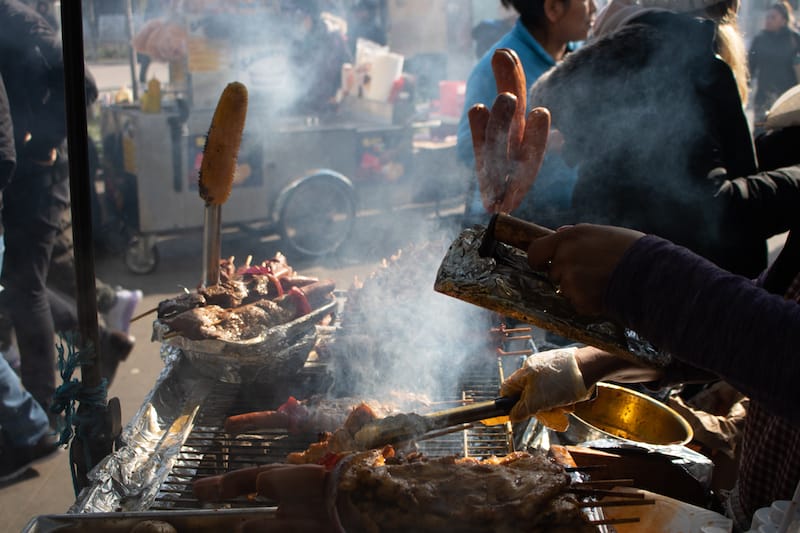
Shapiro admitted that the movement faces opposition from powerful interests beyond de Blasio. This includes everyone from real estate developers to business improvement districts to even some biking activists, who claim that vendors block designated lanes. The obstacles extend beyond permits, as well. Even vendors with permits often struggle to find a legal spot for their carts and face animosity from commercial businesses, which often have the city on their side. “Business improvement districts have whitewashed so many of our commercial corridors and filled them with chain stores that have really kind of undercut the way in which local entrepreneurs can open their own small businesses,” Senator Ramos said.
As the city seeks to appease developers, food vendors are left behind. Ironically, two high-profile attractions in New York – Smorgasburg and the Queens Night Market – are built around street food. As Shapiro explained, though, “the city likes the idea of vending in areas where it can be tightly controlled and managed.” Ramos said that the Queens Night Market has become part of the borough’s social fabric. Besides her bill, she’s also working with the MTA to convert vacant retail areas in the transportation hub at 74th St. into an indoor space for street vendors.
The Queens Night Market, Senator Ramos’s collaboration with the MTA, and détentes with the police are all positive steps forward, but they’re not permanent solutions, advocates say. “The city has never considered vendors as legitimate as other types of small businesses,” Shapiro told us. “That’s basically what it comes down to.”
Rosa, one of the vendors that Ochoa, the community organizer, works with, has been selling homemade Ecuadorian food for 20 years, ten of those in Corona Plaza. Over a small charcoal grill, she cooks skewers of meat, with corn and hot dogs sticking up from her cart like bouquets of flowers. Street vending is “a tradition of my family,” she told us in Spanish. “My mom sold in Ecuador, and now it’s something that I like to do – to cook and sell and be in the street with people. I don’t like being at home.” She said that she works every day because if she doesn’t, her regulars get upset.
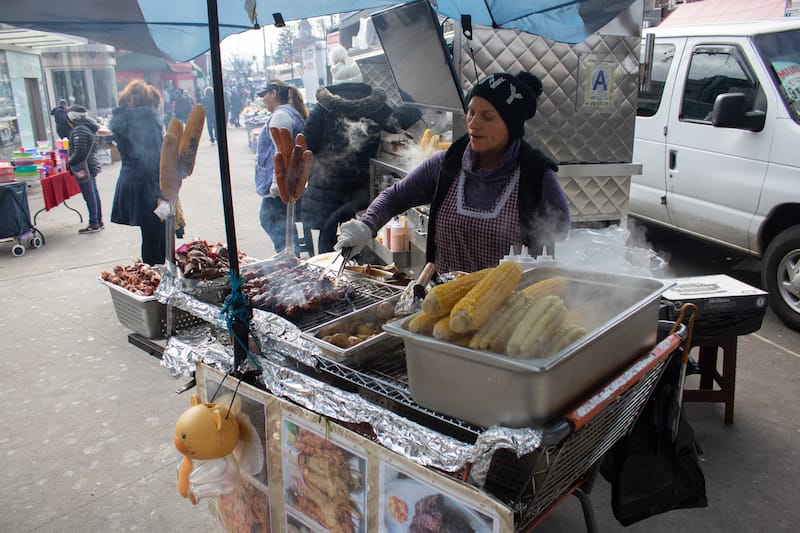
Rosa has been working with the Street Vendor Project for four years now, and said they have helped her with tickets and to understand city ordinances because she doesn’t speak English. “Mateo is great,” she said, referring to Shapiro. “He helps us with everything.”
Nearby, another vendor – Janet – was making tamales, morcilla, ceviche, tamales, and a handful of other dishes, all homemade. Like Rosa and Ochoa, Janet said her mother was also a food vendor. “We came from Ecuador with this tradition,” Janet told us in Spanish. She chose to be a street vendor so she can watch her kids and have time at home. “I work for myself,” she said. “I don’t have a job and I make my own schedule.”
Janet and Rosa have both faced harassment from the police, from tickets to the threat of arrest. For now, though, everything is tranquil. Janet said as long as she keeps her cart clean, the police leave her alone. Still, she hopes to someday have a permit. “We have to keep fighting,” she said.
Leo SchwartzLeo Schwartz and Melanie Einzig
Published on March 04, 2020
Related stories
July 8, 2022
Marseille | By Jenine Abboushi
MarseilleThe storefront restaurant Camas Sutra (a play on its location in the Camas neighborhood of Marseille) still sports “Boucherie, Charcuterie, Crèmerie” on the original red and yellow banners, left over from just 18 months ago when it was home to a neighborhood butcher. The “no restaurant sign” tactic, occasionally seen these days in hip neighborhoods…
June 20, 2023
Naples | By Culinary Backstreets
NaplesEditor’s note: Anya von Bremzen is the winner of three James Beard awards, a contributing writer at AFAR magazine and the author of six cookbooks. Her forthcoming book National Dish: Around the World in Search of Food, History, and the Meaning of Home, she explores the connections between place and identity in six food capitals…
June 2, 2023
Tbilisi | By Pearly Jacob
TbilisiFew locals, let alone tourists have reached the isolated mountain village of Ghebi in Georgia’s northern borderlands of Racha. However, many have passed through the doors of its namesake basement restaurant in the bustling left bank district of Marjanishvili in downtown Tbilisi. For more than a decade, the eatery has been steadily serving up comfort…















































